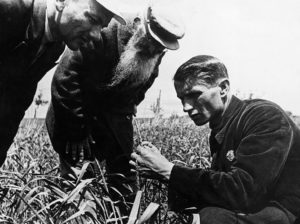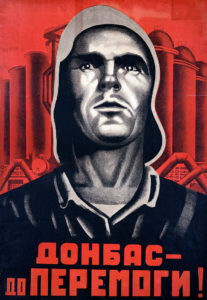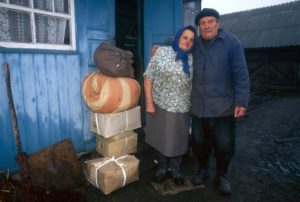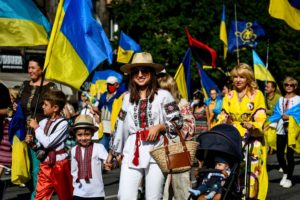-
The Ancient World
- Building Societies – What Does it Take? – Lesson
- Building Societies – What Does it Take? – Quiz
- Athens, Rome, and Jerusalem: Where Western Civilization Began – Lesson
- Athens, Rome, and Jerusalem: Where Western Civilization Began – Quiz
- Persia: Where Fake News Began? – Lesson
- Persia: Where Fake News Began? – Quiz
- Tell Brak: The World’s Most Ancient City? – Lesson
- The Key to Ancient Egypt: Rosetta Stone 200 Years On – Lesson
- The Key to Ancient Egypt: Rosetta Stone 200 Years On – Quiz
- Ancient Rock Art Suggests Humans Occupied Earth 13,000 Years Ago – Lesson
- Ancient Rock Art Suggests Humans Occupied Earth 13,000 Years Ago – Quiz
-
World History
- Slavery: An Ancient Evil That Still Exists Today – Lesson
- A Tale Of Two Sacrifices – Part I – Lesson
- A Tale Of Two Sacrifices – Part II – Lesson
- The Story Behind the Israel-Palestine Conflict – Lesson
- Churchill Vs. Hitler: Standing Up for Europe – Lesson
- War, Peace, and School Bullies – Lesson
- Survey Says: Millennials and Gen Z Just Don’t Know the Holocaust – Lesson
- V-J Day: Celebrating 75 Years Since Japan’s Surrender – Lesson
- A History of Ukraine: Battleground for Empires – Part 1 – Lesson
- A History of Ukraine: Battleground for Empires – Part 1 – Quiz
- A History of Ukraine: Battleground for Empires – Part 2 – Lesson
- A History of Ukraine: Battleground for Empires – Part 2 – Quiz
- History of the Holy Land – Quiz
-
U.S. Allies and Rivals
-
Around the Globe Today
- Chinese Uighurs – What Is Going On? – Lesson
- A New Republic – Barbados Removes the Queen as the Head of State – Lesson
- A New Republic – Barbados Removes the Queen as the Head of State – Quiz
- Venice Makes a New Rule for Tourists – Will Other Cities Follow? – Lesson
- Venice Makes a New Rule for Tourists – Will Other Cities Follow? – Quiz
- Professor Lives Underwater for 100 Days – Lesson
- Professor Lives Underwater for 100 Days – Quiz
- Setenil de las Bodegas – The Spanish Town Built Under a Rock – Lesson
- Setenil de las Bodegas – The Spanish Town Built Under a Rock – Quiz
- Hat of Napoleon Bonaparte Sells for Over $2 Million at Auction – Lesson
- Hat of Napoleon Bonaparte Sells for Over $2 Million at Auction – Quiz
- The UK Plans to Measure Kids’ Bellies to Monitor Their Health – Lesson
- The UK Plans to Measure Kids’ Bellies to Monitor Their Health – Quiz
- Radioactive Wolves in Chernobyl – Lesson
- Radioactive Wolves in Chernobyl – Quiz
- Slovakian Aircar Carries First Passenger – Lesson
- Slovakian Aircar Carries First Passenger – Quiz
- Japan’s Floating City – The Future of Urban Planning? – Lesson
- Japan’s Floating City – The Future of Urban Planning? – Quiz
-
Politics and Economics Around the Globe
A History of Ukraine: Battleground for Empires – Part 2 – Lesson

Soviet scientist Trofim Lysenko measures the growth of wheat in a collective farm field in Ukraine. (Photo by © Hulton-Deutsch Collection/CORBIS/Corbis via Getty Images)
Ukraine finally gains independence – but could that really be the end of the story?
The Ukrainian Soviet Socialist Republic
Under the Soviet Union, Ukraine existed as the Ukrainian Socialist Soviet Republic.
The Soviet Union had taken over a lot of land in Europe and Asia, so it now had 14 republics, as well as Russia. How was it going to manage all these different peoples?
During the old days of Imperial Russia, there was a policy of “Russification.” This means Russia tried push its own culture in conquered lands, banning native ones. Now, the Soviets tried the opposite method. In the early years, it had a policy of “Korenizatsiya,” which promoted the native cultures of each republic under its control. In Ukraine, this was called “Ukrainization.” The Ukrainian language and culture were promoted. But this didn’t last. By 1940, Ukrainization was out, and Russification was back in.

Aside from the conflict over the native culture, there was also great hardship. The Soviet Union’s communist policies didn’t let individual people own land, so farms were taken over and run by the government, or by communes. The communists thought this would increase the amount of food grown, but it had the opposite effect.
Ukraine suffered a terrible famine, called the Holodomor. Anyone who opposed the Soviet policies was also killed or arrested. It’s thought the Holodomor killed between around three million and ten million people. Today, there is still disagreement on whether it was a planned genocide of the Ukrainian people or just the grave result of bad ideas. Many Russians and other Soviet peoples also starved and suffered under communism.

Soviet propaganda poster entitled “Donbas” (Until We Overcome), showing the face of a factory worker in front of factory buildings in the Ukraine. Lithograph, circa 1930-35. (Photo by VCG Wilson/Corbis via Getty Images)
World War II arrived. While most Ukrainian soldiers fought with the Soviet Red Army, nationalist groups began again to spring up in the west, such as the Ukrainian Insurgent Army. In 1941, Nazi Germany held a surprise invasion and took over part of Ukraine, called the “Reichskommissariat Ukraine,” but two years later the Germans had to retreat from Soviet attack.
After World War II, the Soviet Union became more powerful, growing into one of the world’s two superpowers. It competed against the United States for power on the world stage. Life in the Soviet Union continued to be harsh, though, and Ukraine suffered from famines, poverty, and totalitarian rule.
Ukraine grew as a center of industry, making a lot of items in factories. The Chernobyl nuclear power plant was built on the republic’s northern border in the 1970s, but in 1986 it exploded. This is still considered one of the worst nuclear accidents in history. The radiation caused hundreds of deaths. An area of 30 kilometers (18 miles) was evacuated, including over 100,000 people. Today, the health effects of the accident are not fully known, and the Chernobyl area is still radioactive.
Eventually, Soviet power began to wane. Ukrainian nationalism slowly grew. “Ukrainization” was back. In 1989, a new constitution was approved, making Ukrainian the only official language in the republic.
Finally, on December 25, 1991, the Soviet Union collapsed. Just a few weeks before that, on December 1, the Ukrainian people had voted to become an independent nation.

Couple evacuating their home near Chernobyl. (Photo by Pascal Le Segretain/Sygma via Getty Images)
Independent Ukraine
Finally, Ukraine was recognized as an independent nation. The native culture and language were promoted, and in 1996 a new constitution was adopted. The media became more open, and new ideas were allowed to flourish. There were problems, though. The country was still poor, and crime increased. In 2004, Ukraine almost collapsed; the government was accused of corruption and the people took to the streets, protesting in what is now called the Orange Revolution.
Ukraine distanced itself from Russia and adopted a more Western, or European, identity. Tensions began to arise. Not everyone wanted to be a part of the Western-style Ukraine. Some groups wanted to keep close ties with Russia. Since then, Ukraine has been pulled in two directions – should it join the rest of Europe, or stay allied with Russia? Different regions have different opinions, and it has caused warfare in the country.

A procession celebrating the 30th anniversary of Ukraine’s independence, 2021. (Photo credit should read Dmytro Smolyenko/ Ukrinform/Future Publishing via Getty Images)
Conflict erupted in 2014 between pro-European western Ukraine and pro-Russian eastern Ukraine. The eastern “Donbas” region of the country rebelled, with help from Russia.
Russia’s top officials still think Ukraine should belong to their country, and it launched an invasion in 2022. However, Ukraine has fought fiercely to keep its independence.
Russia, Poland, Mongolia, Cossacks, Austria-Hungary – these entities, and more, have all had a hand in shaping the lands of Ukraine. With a long history of division and control by diverse empires, it’s no surprise that different areas of Ukraine have grown with different identities. Can these conflicts be resolved, or will the country be pulled apart?